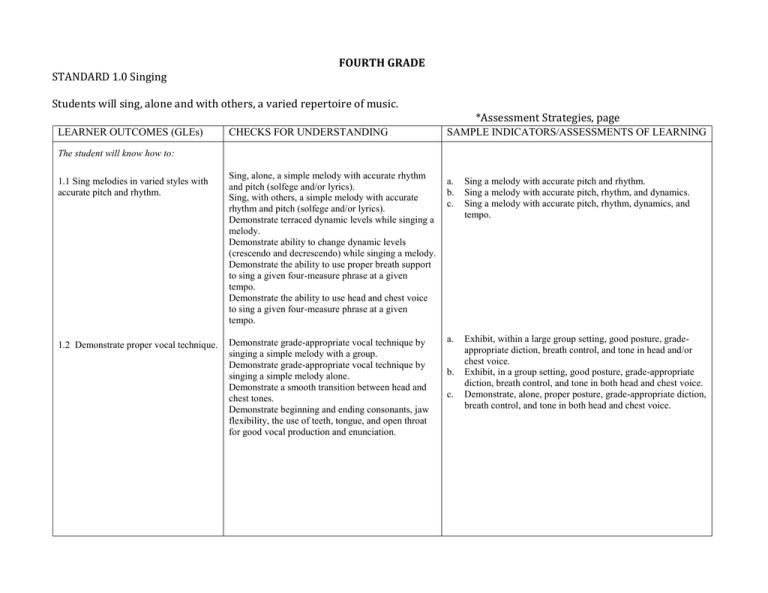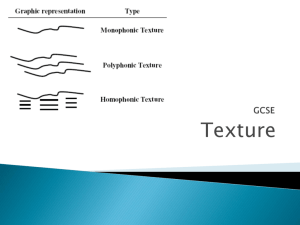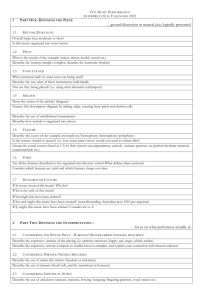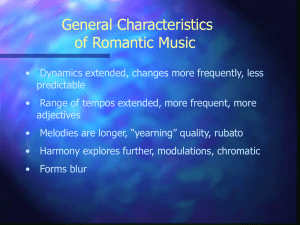Objectives
advertisement

STANDARD 1.0 Singing FOURTH GRADE Students will sing, alone and with others, a varied repertoire of music. LEARNER OUTCOMES (GLEs) CHECKS FOR UNDERSTANDING *Assessment Strategies, page SAMPLE INDICATORS/ASSESSMENTS OF LEARNING The student will know how to: 1.1 Sing melodies in varied styles with accurate pitch and rhythm. 1.2 Demonstrate proper vocal technique. Sing, alone, a simple melody with accurate rhythm and pitch (solfege and/or lyrics). Sing, with others, a simple melody with accurate rhythm and pitch (solfege and/or lyrics). Demonstrate terraced dynamic levels while singing a melody. Demonstrate ability to change dynamic levels (crescendo and decrescendo) while singing a melody. Demonstrate the ability to use proper breath support to sing a given four-measure phrase at a given tempo. Demonstrate the ability to use head and chest voice to sing a given four-measure phrase at a given tempo. Demonstrate grade-appropriate vocal technique by singing a simple melody with a group. Demonstrate grade-appropriate vocal technique by singing a simple melody alone. Demonstrate a smooth transition between head and chest tones. Demonstrate beginning and ending consonants, jaw flexibility, the use of teeth, tongue, and open throat for good vocal production and enunciation. a. b. c. Sing a melody with accurate pitch and rhythm. Sing a melody with accurate pitch, rhythm, and dynamics. Sing a melody with accurate pitch, rhythm, dynamics, and tempo. a. Exhibit, within a large group setting, good posture, gradeappropriate diction, breath control, and tone in head and/or chest voice. Exhibit, in a group setting, good posture, grade-appropriate diction, breath control, and tone in both head and chest voice. Demonstrate, alone, proper posture, grade-appropriate diction, breath control, and tone in both head and chest voice. b. c. 1.3 Demonstrate skills for singing harmony. Sing, with others, the melodies of two partner songs, one at a time. Sing the melody of one partner song accompanied by a recording of the second song. Sing, in a group, the melody of one partner song while another group sings the melody of the other partner song. Demonstrate beginning and ending consonants for good enunciation. Demonstrate jaw flexibility for good vocal production and enunciation. Demonstrate the use of teeth and tongue for good vocal production and enunciation. Demonstrate open throat for good vocal. Sing a partner song with student leaders while teacher maintains tempo. Sing a partner song with student leaders while the teacher or a student conducts. Sing the melody of a round/canon in a group. Sing a round/canon in two and/or three parts in a group. a. b. c. Sing partner songs (two songs) in small and/or large groups. Sing partner songs (two or three songs) in small and/or large groups. Sing partner songs and rounds and/or canons in small and/or large groups. STANDARD 2.0 Playing Instruments FOURTH GRADE Students will perform on instruments, alone and with others, a varied repertoire of music. *Assessment Strategies, page LEARNER OUTCOMES (GLEs) CHECKS FOR UNDERSTANDING SAMPLE INDICATORS/ASSESSMENTS OF LEARNING Demonstrate, alone, teacher-selected, developmentally and/or grade-appropriate rhythms on non-pitched instruments using proper technique. Demonstrate, in a group, teacher selected, developmentally and/or grade-appropriate rhythms on non-pitched instruments using proper technique. a. The student will know how to: 2.1 Demonstrate basic rhythmic patterns in duple and triple meter on non-pitched instruments using correct technique. b. c. 2.2 Demonstrate simple melodies on pitched instruments using correct technique. Play, alone, a teacher-selected example demonstrating developmentally and/or gradeappropriate technique and correct notes on a pitched instrument. Play, in a group, a teacher-selected example demonstrating developmentally and/or gradeappropriate technique and correct notes on a pitched instrument. a. b. c. Perform basic rhythmic patterns (half notes, quarter notes, paired eighth notes, quarter rests) in duple meter on nonpitched instruments using proper technique. Perform basic rhythmic patterns (half notes, dotted half notes, quarter notes, paired eighth notes, quarter rests) in duple and triple meters on non-pitched instruments using proper technique. Perform rhythmic patterns (half notes, dotted half notes, quarter notes, eighth notes, half rests, and quarter rests) in duple and triple meters on non-pitched instruments using proper technique. Perform, alone, simple melodies on a pentatonic scale (fourmeasure minimum). Perform, alone or in groups, melodies based on selected major scales including steps, skips, leaps, and repeated notes (fourmeasure minimum). Perform melodies based on selected major and/or minor scales. 2.3 Demonstrate simple rhythmic and/or melodic accompaniments using correct technique. 2.4 Demonstrate simple melodies with appropriate expressive markings. Demonstrate, alone, a teacher-selected, developmentally and/or grade-appropriate rhythmic accompaniment. Demonstrate, alone, a teacher-selected, developmentally and/or grade-appropriate melodic accompaniment. Demonstrate, in a group, a teacher-selected, developmentally and/or grade-appropriate rhythmic accompaniment. Demonstrate, in a group, a teacher-selected, developmentally and/or grade-appropriate melodic accompaniment. Demonstrate an understanding of a simple score for pitched instruments (e.g., an Orff instrumental score), a rhythmic score for non-pitched instruments, or a score for a recorder ensemble. a. Identify tempo changes and dynamics using a listening map for a given recorded selection. Play a simple melody with tempo and/or dynamic changes in a large group setting. Play a simple melody with tempo and/or dynamic changes in a small group setting. Demonstrate, with others, the ability to follow the tempo markings in a piece of music, as set by the conductor or with a recording. Demonstrate developmentally and/or gradeappropriate use of expressive markings. a. b. c. b. c. Perform a basic accompaniment in duple meter on pitched (two-note chords, broken two- note and three-note chords) and on non-pitched (steady beat) instruments. Perform an accompaniment in duple and/or triple meter using basic rhythms on pitched instruments (two-note chords, broken two-note chords, three-note chords, and/or arpeggios), and an accompaniment in duple and/or triple meters using varying rhythm patterns (dotted half notes, half notes, quarter notes, paired eighth notes, quarter rests) on non-pitched instruments. Perform an accompaniment on pitched and non-pitched instruments using a score that includes varying rhythms, pitches and parts. Demonstrate tempo changes and dynamics when playing a music example. Demonstrate dynamics, phrasing and tempo changes when playing a music example. Demonstrate expressive qualities in performance (e.g., dynamics, balance, tempo changes, phrase markings). FOURTH GRADE STANDARD 3.0 Improvising Students will improvise melodies, variations, and accompaniments. *Assessment Strategies, page LEARNER OUTCOMES (GLEs) CHECKS FOR UNDERSTANDING SAMPLE INDICATORS/ASSESSMENTS OF LEARNING 3.1 Improvise, vocally and/or instrumentally, two-measure melodies using a pentatonic scale. Improvise a developmentally and/or gradeappropriate melody using a pentatonic scale on a pitched instrument. a. 3.2 Improvise rhythmic patterns. Improvise developmentally and/or grade-appropriate rhythms using body percussion, pitched, and/or nonpitched instruments. a. The student will know how to: b. c. b. c. 3.3 Improvise, vocally and/or instrumentally, questions and/or answers. Improvise a developmentally and/or gradeappropriate question phrase. Improvise a developmentally and/or grade-appropriate answer to a given question phrase. a. b. c. 3.4 Improvise a simple instrumental accompaniment. Improvise a developmentally and/or gradeappropriate simple rhythmic accompaniment or ostinato accompaniment on pitched or non-pitched instruments. a. b. c. Improvise an eight-beat melody using a pentatonic scale within teacher-given parameters. Improvise an eight-beat melody using a pentatonic scale. Improvise, on a variety of instruments, an eight-beat melody using a pentatonic scale. Improvise an eight-beat rhythm pattern consisting of half notes, quarter notes, paired eighth notes and quarter rests. Improvise an eight-beat pattern using half notes, quarter notes, paired eighth notes and/or quarter rests while maintaining a steady tempo. Improvise an eight-beat pattern using half notes, quarter notes, paired eighth notes, quarter rests and/or half rests while maintaining a steady tempo. Improvise an answer to a teacher-given eight-beat question using body percussion or non- pitched instruments Improvise, with a partner, a four- or eight-beat question and answer using body percussion or non-pitched instruments. Improvise, with a partner, a four- or eight-beat question and answer on pitched instruments (may include recorder). Improvise a simple four-beat accompaniment on body percussion or non-pitched instruments within teacher-given parameters. Improvise a simple eight-beat accompaniment on body percussion or non-pitched instruments within teacher-given parameters. Improvise a simple eight-beat accompaniment on non-pitched or pitched instruments within teacher-given parameters. FOURTH GRADE STANDARD 4.0 Composing Students will compose and arrange music within specified guidelines. *Assessment Strategies, page LEARNER OUTCOMES (GLEs) CHECKS FOR UNDERSTANDING SAMPLE INDICATORS/ASSESSMENTS OF LEARNING Create a four-measure melodic composition. Create a four-measure melodic composition in AB form. Create a four-measure melodic composition in ABA form. a. Create a four-measure melodic based on a pentatonic scale. Create a four-measure melodic based on a major scale. a. The student will know how to: 4.1 Compose a simple four-measure melody in binary and/or ternary form. 4.2 Compose a simple four-measure melody on a major and/or minor scale. b. c. b. c. 4.3 Compose, vocal or instrumental, a short melodic introduction, interlude, and/or coda using teacher-given parameters. Discuss the definition of an introduction. Demonstrate a teacher-guided introduction in a large group. Discuss the definition of interlude and recognize one in a listening example. Create an interlude using teacher-given parameters. Discuss the definition of coda. Demonstrate the ability to locate a coda in a music score. Create an introduction, interlude, and/or coda. a. b. c. Create and demonstrate a four-measure melodic question/answer composition. Create and demonstrate a four-measure melodic composition in AB form. Create and demonstrate a four-measure melodic composition in ABA form. Create and demonstrate a four-measure melody based on a pentatonic scale. Create and demonstrate a four-measure melody based on a given pentatonic or major scale Create and demonstrate a four-measure melody based on a given major or minor scale. Create and demonstrate a short introduction and coda for a given melody. Create and demonstrate a short introduction, interlude, and coda for a given melody. Create and demonstrate a two- to four-measure interlude for a given melody. FOURTH GRADE STANDARD 5.0 Reading and Notating Students will read and notate music. *Assessment Strategies, page LEARNER OUTCOMES (GLEs) CHECKS FOR UNDERSTANDING SAMPLE INDICATORS/ASSESSMENTS OF LEARNING Demonstrate, through the use of manipulatives or movement, an understanding of notes on the lines and spaces of a treble clef staff. Demonstrate, by notating, an understanding of notes on the lines and spaces of a treble clef staff. a. The student will know how to: 5.1 Identify and explain symbols represented in rhythm and melody. b. c. 5.2 Use symbols to read, notate and perform. Demonstrate, through movement, an understanding of time signature/meter (duple and triple). Identify the placement of time signature/meter on the staff. Determine the meter of a music example by identifying the number of beats in each measure. Sing and/or play a simple three-note melody using teacher-given solfege. a. b. c. Identify meters (duple and triple), note names on a treble clef staff, note values (half notes, quarter notes, paired eighth notes), and quarter rests. Compare meters (duple and triple); identify note names on a treble clef staff, note values (whole notes, half notes, quarter notes, paired eighth notes), and rest values (half rest, quarter rests). Compare and contrast meters (duple and triple); identify note names on a treble clef staff, note values (dotted half notes, half notes, quarter notes, paired eighth notes, sixteenth notes), and rest values (half rests, quarter rests). Demonstrate pitch understanding using teacher-given solfege symbols. Demonstrate pitch understanding using solfege (or other teacher-provided) symbols. Demonstrate an understanding of treble clef pitches by singing intervals using both solfege and letter names or by playing intervals on an instrument. 5.3 Identify and interpret terms and symbols referring to musicality. Identify dynamic markings through a teacher-guided classroom activity. Identify directional markings through a teacherguided classroom activity. Follow dynamic markings in a teacher-given listening example. Follow directional markings in a teacher-given listening example. Demonstrate, vocally, an understanding of dynamic markings. Demonstrate, instrumentally, an understanding of dynamic markings. Demonstrate, vocally, an understanding of directional markings. Demonstrate, instrumentally, an understanding of directional markings. a. b. c. Identify and demonstrate dynamic markings (e.g., fortissimo, forte, mezzo forte, mezzo piano, piano, pianissimo, crescendo, decrescendo) within a given music selection. Identify and demonstrate dynamic markings (e.g., fortissimo, forte, mezzo forte, mezzo piano, piano, pianissimo, crescendo, decrescendo) and tempo markings (e.g., andante, largo, presto, ritardando) within a given music selection. Identify and demonstrate dynamic markings (e.g., fortissimo, forte, mezzo forte, mezzo piano, piano, pianissimo, crescendo, decrescendo), tempo markings (e.g., andante, largo, presto, ritardando), and articulation markings (e.g., staccato, marcato, accents) within a given music selection. FOURTH GRADE STANDARD 6.0 Listening and Analyzing Students will listen to, analyze and describe music. *Assessment Strategies, page LEARNER OUTCOMES (GLEs) CHECKS FOR UNDERSTANDING SAMPLE INDICATORS/ASSESSMENTS OF LEARNING Identify rondo form in listening examples. Demonstrate the similarities and differences between rondo form and AB and/or ABA forms. Demonstrate an understanding of rondo form using movement. Demonstrate an understanding of rondo form using manipulatives. Identify theme and variations in a given listening example. Demonstrate an understanding of theme and variations using movement. Demonstrate an understanding of theme and variations using manipulatives. a. Classify, visually or aurally, given instruments into their orchestral families. a. The student will know how to: 6.1 Demonstrate same and different sections through varying methods. 6.2 Identify and classify, visually and aurally, orchestral instruments individually and/or by family. b. c. b. c. 6.3 Describe, both orally and written, the characteristics of musical selections (vocal and instrumental). Select appropriate vocabulary from a word bank to describe a music selection. Compare and contrast given music selections using a graphic organizer. a. b. c. Demonstrate an understanding of different sections of complex forms (e.g., rondo, theme and variations) using manipulatives. Create a pictorial representation of different sections of complex forms (e.g., rondo, theme and variations) of music. Create movement patterns to demonstrate different sections of complex forms of music. Recognize selected orchestral, band, folk, and/or ethnic instruments and classify into families. Identify, visually, teacher-selected orchestral instruments and group into families. Identify, through listening examples, teacher-selected instruments, individually and as families. Describe a listening example using teacher-given characteristics. Classify the elements of music using teacher-given vocabulary. Describe a listening example using correct music vocabulary. 6.4 Identify and describe various styles and genres (vocal and instrumental) of music. Classify styles of music through listening examples. Classify genres of music through listening examples. a. b. c. Describe stylistic characteristics of selected regional, national, and/or global styles and/or genres (e.g., lullaby, march, jazz, folk song, patriotic, work song, spiritual, Tennessee song, ethnic music) of music using teacher-given parameters. Classify styles and/or genres of music using teacher-given vocabulary. Analyze teacher-given styles and/or genres of music. FOURTH GRADE STANDARD 7.0 Evaluating Students will evaluate music and music performances. *Assessment Strategies, page LEARNER OUTCOMES (GLEs) CHECKS FOR UNDERSTANDING SAMPLE INDICATORS/ASSESSMENTS OF LEARNING Describe a music selection using a teacher-given word bank. Discuss the elements of a music selection within teacher-given parameters. a. The student will know how to: 7.1 Devise and apply, with teacher guidance, criteria for evaluating music and music performances. b. c. 7.2 Demonstrate proper audience etiquette and evaluate audience behavior during performances. Discuss and create, as a class, guidelines for audience etiquette. Create a rubric for evaluating audience etiquette. a. b. c. Discuss a music selection or student performance using gradeappropriate music vocabulary and teacher-given criteria. Develop a criteria, with teacher guidance and using gradeappropriate music vocabulary, to evaluate a performance.. Evaluate, in a group, a student or professional performance using student developed criteria. Discuss and demonstrate appropriate audience member behavior in a classroom setting. Demonstrate appropriate audience behavior in a formal performance setting. Evaluate one’s own audience behavior. FOURTH GRADE STANDARD 8.0 Interdisciplinary Connections Students will understand relationships between music, the other arts, and disciplines outside the arts. *Assessment Strategies, page LEARNER OUTCOMES (GLEs) CHECKS FOR UNDERSTANDING SAMPLE INDICATORS/ASSESSMENTS OF LEARNING Identify commonalities between music and dance. Create short dramatizations to music selections and relate to theatre. Identify common themes between music and visual art (e.g., Pastoral Symphony by Ludwig van Beethoven and Wooded Landscape by Jeanne Francois Millet) using examples from textbooks or websites. a. b. Explain the relationship between music and mathematics (e.g., rhythm pyramid). a. The student will know how to: 8.1 Experience and explain the elements of music as they relate to other arts disciplines. 8.2 Investigate and demonstrate ways music interrelates with other academic disciplines. c. b. c. Discuss similarities between music and dance and visual art. Demonstrate similarities between music and dance (movement) and theatre (dramatizations). Perform, combining aspects of music, dance, and theatre. Demonstrate an ability to enhance a story with the addition of singing, vocal or instrumental sounds, and relate it to the language arts curriculum and/or relate the study of rhythms to the mathematics curriculum. Describe the literary characteristics of song lyrics. Demonstrate the relationship of music to literature, mathematics, science, and/or social studies. FOURTH GRADE STANDARD 9.0 Historical and Cultural Relationships Students will understand music in relationship to history and culture. *Assessment Strategies, page LEARNER OUTCOMES (GLEs) CHECKS FOR UNDERSTANDING SAMPLE INDICATORS/ASSESSMENTS OF LEARNING Discuss and demonstrate traditional music of a selected culture (e.g., African, Native American, Asian, Latin American). Discuss and demonstrate an understanding of a given historical period as related to music studied. a. The student will know how to: 9.1 Describe and perform music of various cultures and historical periods. b. c. Describe music characteristics of selected cultures using teacher-given parameters. Discuss characteristics of selected cultures within a musical and/or historical context using teacher-given parameters. Demonstrate an understanding of selected cultures and/or historical periods through music performance (vocal and/or instrumental).






